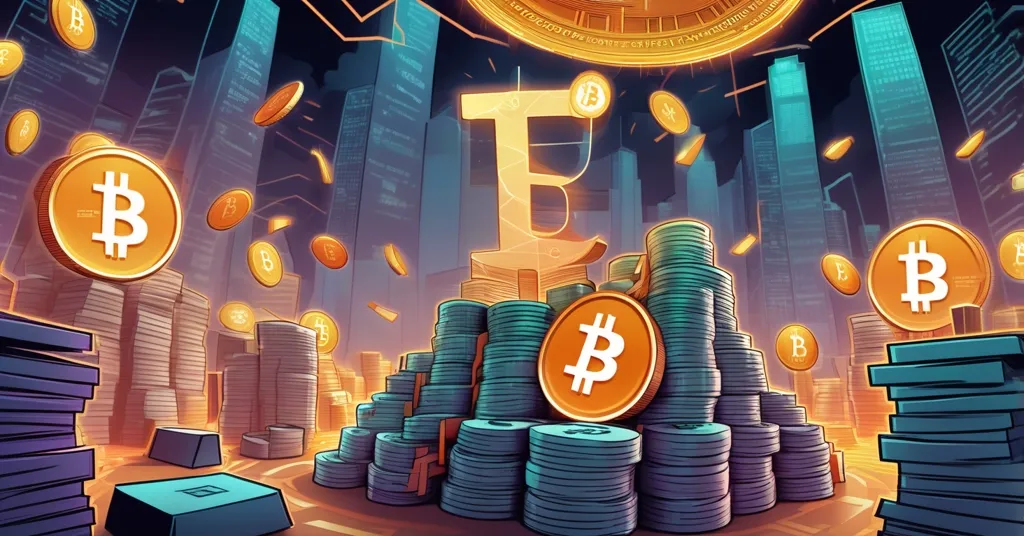Uptober 2024: Crypto ETF Hype and Risky Altcoin Gambles Take Center Stage

Uptober 2024: Crypto’s Big Moment with ETF Hopes and Risky Altcoin Bets
October 2024 has the crypto world buzzing with “Uptober” fever, as the market braces for a potential game-changer: a wave of SEC decisions on 16 cryptocurrency ETF applications. With institutional money knocking at the door and speculative altcoins riding the hype, the stakes couldn’t be higher. Is this the month crypto finally breaks into the mainstream, or just another overhyped cycle ready to crash and burn?
- ETF Milestone: 16 crypto ETF applications hit SEC deadlines in October, the biggest batch in history.
- Institutional Rush: 31 new ETF filings in two months show traditional finance is hungry for crypto exposure.
- Speculative Gambles: Low-cap tokens like Bitcoin Hyper ($HYPER), Best Wallet Token ($BEST), and Aura ($AURA) are pitched as high-risk, high-reward plays.
The ETF Catalyst: A Seismic Shift for Crypto Adoption
The heart of Uptober’s excitement lies in the unprecedented push for crypto Exchange-Traded Funds (ETFs). For the uninitiated, ETFs are financial products that track the price of an asset—like Bitcoin or Ethereum—and trade on traditional stock exchanges. They’re a gateway for regular investors who want crypto exposure without the hassle of managing wallets or navigating shady exchanges. This month, the U.S. Securities and Exchange Commission (SEC) faces deadlines for approving or rejecting a record 16 crypto ETF applications, a landmark moment that could redefine market access. On top of that, 31 new filings over the past two months signal that Wall Street is chomping at the bit to get in on the action.
What’s fueling this frenzy? The SEC recently introduced generic listing standards, allowing spot crypto and altcoin ETFs to trade on major exchanges like Nasdaq, CBOE, and NYSE without the red tape of individual approvals. This regulatory pivot is a massive deal—it’s like opening the floodgates for institutional capital. Bloomberg ETF analyst Eric Balchunas has estimated a 90% or higher chance of multiple approvals by 2025, and recent developments have only bolstered those odds. His track record on ETF predictions adds weight to the optimism, suggesting we could see a tidal wave of new money flowing into the space.
Why should you care? Crypto ETFs could be the bridge that brings Bitcoin and its peers into every retirement portfolio and hedge fund. They lower the entry barrier for traditional investors who wouldn’t dream of touching a private key, offering a familiar, regulated way to invest. This isn’t just about price pumps—it’s about legitimacy. More capital means more stability over time, potentially smoothing out some of crypto’s infamous volatility. For Bitcoin maximalists like myself, who see BTC as the ultimate store of value and a middle finger to centralized finance, this is a bittersweet win. Mass adoption is the goal, but it comes with trade-offs. ETFs might dilute the ethos of self-custody—owning your own keys, not trusting a third party—which is the bedrock of Bitcoin’s freedom-first philosophy.
Let’s not get carried away with the hype, though. Regulatory clarity cuts both ways. If the SEC drags its feet or slaps down key approvals, we could see a market tantrum that sends prices spiraling. Even if approvals happen, there’s a risk of centralization—think big custodians holding massive chunks of Bitcoin for ETF investors, potentially undermining the decentralized network. And what about miners? If institutional buying drives up prices, mining rewards skyrocket, but so does the energy scrutiny. Plus, post-approval regulatory overreach could creep in, with governments imposing stricter rules under the guise of “protecting investors.” Bitcoin’s security and scarcity remain unmatched, but ETFs could introduce vulnerabilities we can’t yet predict. The road to mainstream isn’t a straight line—it’s a damn obstacle course.
Macro Factors Bolstering Uptober’s Momentum
Zooming out, Uptober’s optimism isn’t happening in a vacuum. The broader economic landscape is nudging investors toward crypto as a hedge. With inflation fears lingering, interest rates in flux, and geopolitical tensions simmering—think Middle East conflicts or U.S. election uncertainty—Bitcoin is increasingly seen as digital gold, a safe haven from fiat devaluation. Historical October rallies, like the 2021 surge when Bitcoin hit $69,000 amid altcoin mania, add to the seasonal hype. Past performance isn’t a guarantee, but the pattern of autumn pumps has crypto Twitter abuzz with memes and moon predictions. Still, let’s keep our heads on straight—seasonality is folklore until proven otherwise, and macro conditions can flip on a dime. A sudden rate hike or global crisis could tank risk assets, crypto included.
Speculative Side Bets: Low-Cap Tokens in the Spotlight
As ETF anticipation pumps fresh energy into the market, speculative fever is spiking around smaller projects. Low-cap cryptocurrencies—tokens with small market capitalizations and big dreams—are often the go-to for risk-takers hoping to catch lightning in a bottle. Think of the 2021 altcoin season, when obscure tokens soared thousands of percent on pure hype. Three such projects making noise right now are Bitcoin Hyper ($HYPER), Best Wallet Token ($BEST), and Aura ($AURA). Each represents a different flavor of crypto—innovation, utility, and cultural buzz—but they all carry a neon sign reading “high risk.” Let’s dissect them with a skeptical eye, because while the potential upside sounds seductive, the downside can gut you faster than a bear market. For insights into trending picks during this Uptober hype, check out some of the top cryptocurrencies to watch as ETF approvals loom.
First, there’s Bitcoin Hyper ($HYPER), a Layer-2 solution aiming to turbocharge Bitcoin’s capabilities. Layer-2 tech is built atop a primary blockchain to solve issues like slow transaction speeds and high fees—Bitcoin’s Achilles’ heel. $HYPER uses the Solana Virtual Machine (SVM), a framework that mimics Solana’s lightning-fast processing, to bring Web3 and DeFi tools to Bitcoin. We’re talking smart contracts (self-executing agreements on the blockchain) and decentralized apps (dApps) that could rival Ethereum’s ecosystem, all while leveraging Bitcoin’s security. With a reported 51% staking reward—earning yearly returns by locking up tokens to support the network—it’s a juicy pitch for yield seekers. But here’s the reality check: Layer-2 adoption is a slog. Bitcoin’s hardcore community often resists off-chain solutions, viewing them as a betrayal of the original vision. Technical hiccups or low uptake could render $HYPER a ghost town. And those wild claims of turning $100 into thousands? Pure fantasy meant to bait the FOMO crowd. If it delivers, great; if not, it’s another footnote in the graveyard of failed projects.
Next up is Best Wallet Token ($BEST), the native token of Best Wallet, a non-custodial crypto wallet. Non-custodial means you control your own funds via private keys, unlike centralized exchanges where a hack or rug pull can wipe you out. Best Wallet touts user-friendly features like scam protection and early access to token presales, tapping into a market projected to reach $100 billion by 2033 with a 26.3% annual growth rate. $BEST, in presale at a fraction of a cent, offers an 80% staking yield, with some hyping a rise to over 60 cents by 2026. Sounds like a solid utility play, right? Not so fast. The wallet space is a shark tank—giants like MetaMask and Trust Wallet already own the market. Can Best Wallet stand out, or is it just late to the party? Worse, presales are notorious for pump-and-dump scams. Those astronomical return predictions aren’t optimism—they’re often straight-up lies to fleece the gullible. Approach with extreme caution.
Finally, there’s Aura ($AURA), a meme coin riding the viral internet trend of “Aura points,” a cultural joke about social charisma or clout. Meme coins are the wild cards of crypto—driven by community hype rather than tech or utility. $AURA has surged over 2,200% since June 2024, though it’s currently cooling off, potentially gearing up for another run. They embody the rebellious, screw-the-system vibe of crypto, and early adopters can make a killing. But let’s not sugarcoat it—meme coins are the equivalent of a viral internet prank: hilarious until the joke’s on you. Most crash to zero once the buzz fades, leaving latecomers holding worthless tokens. Betting on $AURA is like wagering on a TikTok trend to stay hot. If ETF approvals lift market sentiment, it might pop again, but don’t stake your rent on it.
Bitcoin Remains King: Maximalism Amid the Noise
As a Bitcoin maximalist at heart, I’ll always argue that BTC is the gold standard of this space. Its scarcity—capped at 21 million coins—security, and battle-tested decentralization make it the ultimate tool for financial freedom and privacy. No altcoin or ETF can replicate its ethos. That said, I’m not blind to the innovation happening elsewhere. Layer-2 projects like $HYPER could extend Bitcoin’s reach into DeFi, while utility tokens like $BEST highlight real-world applications. Even meme coins like $AURA show how decentralized communities can drive cultural movements. But let’s not lose sight of the forest for the trees—Bitcoin’s value lies in disrupting the status quo, not chasing every shiny new thing. ETFs might bring adoption, but self-custody and skepticism of centralized systems must remain our north star.
The Dark Side of Hype: Scammers and Empty Promises
Here’s where I get brutal. The speculative mania around low-cap tokens, paired with absurd price predictions, is a festering wound in crypto. Claims of 2,000% returns or turning pocket change into a fortune aren’t just optimistic—they’re predatory. Historically, we’ve seen this play out with 2017 ICO scams and 2021 meme coin rug pulls, where grifters hype worthless projects, dump their holdings, and vanish. Presale schemes are especially notorious, preying on FOMO with promises of “getting in early.” I have zero tolerance for this garbage. We’re here to drive responsible adoption, not shill snake oil. If you’re tempted by these low-cap gambles, do your own damn research. Check whitepapers, audit reports, team backgrounds, and community sentiment. If it smells like a scam, it probably is. No one’s handing out free lambos, folks.
Key Questions and Takeaways for Crypto Enthusiasts
- What’s driving the Uptober 2024 excitement in the crypto market?
A record 16 crypto ETF applications facing SEC deadlines, alongside 31 new filings, are fueling optimism and pulling institutional interest into the space. - How might ETF approvals reshape cryptocurrency adoption?
They could bring massive capital and credibility by making crypto accessible through regulated, familiar financial products, though risks of centralization loom. - Are low-cap tokens like $HYPER, $BEST, and $AURA worth considering?
They carry high-reward potential if they succeed or catch hype, but their speculative nature and questionable promises make them a dangerous bet for most. - Can Bitcoin benefit from innovations like Layer-2 solutions?
Yes, projects like $HYPER could tackle scalability and enable DeFi use cases, but widespread adoption by Bitcoin’s purist community is far from guaranteed. - Should you trust bold price predictions for altcoins?
Hell no—these forecasts are often baseless hype meant to lure unsuspecting investors; always dig deeper and approach with hardcore skepticism. - How can you research crypto ETFs or tokens before investing?
Start with official SEC filings for ETFs, study project whitepapers for tokens, track team credibility, and follow community discussions on platforms like Twitter or Discord. - What are safer alternatives to speculative low-cap tokens?
Stick to established assets like Bitcoin or Ethereum, or explore diversified crypto index funds and ETFs if approved, to minimize exposure to unproven projects.
Uptober 2024 is shaping up to be a defining chapter for crypto, with ETF decisions poised to either catapult us toward mainstream acceptance or remind us why this space is an untamed frontier. Bitcoin remains the bedrock of financial sovereignty, but the broader ecosystem—flaws, scams, and all—is part of the chaotic revolution we’re building. The speculative bets on low-cap tokens highlight both the innovation and insanity of this market. So, stay sharp, question everything, and let’s push for a future where decentralized finance isn’t just a buzzword, but a hard-earned reality.



